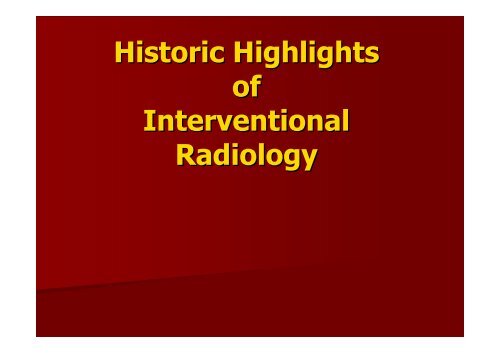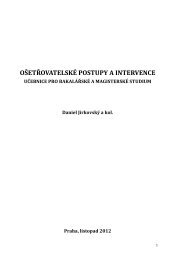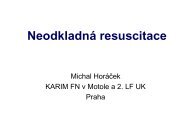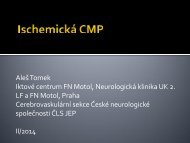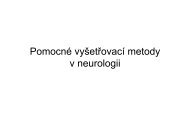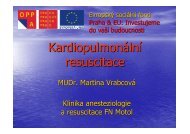Vascular intervention
Vascular intervention
Vascular intervention
Create successful ePaper yourself
Turn your PDF publications into a flip-book with our unique Google optimized e-Paper software.
Historic Highlights<br />
of<br />
Interventional<br />
Radiology
INTERVENTION RADIOLOGY<br />
<strong>Vascular</strong> <strong>intervention</strong><br />
Nonvascular <strong>intervention</strong><br />
- important to establish a good<br />
radiologist/patient relationship<br />
and to obtain informed consent
Father of<br />
IR<br />
PTA
Cardiac<br />
catheterization<br />
and angiographic<br />
techniques<br />
of<br />
future
“A A cardiac catheter can be more than a<br />
tool for passive means for diagnostic<br />
observation; used with imagination it<br />
can become an important surgical<br />
instrument”.<br />
June 1963
Catheters should<br />
replace scalpels
June 1963
5oth year anniversary of Congressus<br />
Radiologicus Cechoslovacus<br />
1963-2013<br />
Planting the seeds of Interventional Radiology<br />
by Charles T Dotter
INTERVENTION RADIOLOGY<br />
The procedure should be undertaken only<br />
if there is a clear clinical indication<br />
Any procedure should d be in the best<br />
interest of the patient<br />
The potential benefits of the procedure<br />
should d outweigh the risk
Analgesia and Sedatio<br />
Interventional techniques require patient<br />
co-operation.<br />
operation.<br />
The patient must be comfortable and pain<br />
free.<br />
The vast majority of work involves – sedation<br />
and analgesic techniques.
Interventional Suit Design
Following the procedure the patients<br />
recovery suite<br />
day ward
1953 I Seldiger: : Percutaneous<br />
catheterization<br />
1964 C Dotter: SFA recanalization<br />
(coaxial catheters)<br />
1974 A Grüntzig: Balloon catheter PTA
PTA<br />
- percutaneous transluminal angioplasty<br />
PTA increases the luminal diameter of a<br />
stenotic artery by causing plaque fracture,<br />
often with accompanying local intima-<br />
medial dissection.
January 16, 1964
Catheter therapy<br />
“Transluminal angioplasty”<br />
was born<br />
January 16, 1964
Balloon Angioplasty<br />
1975<br />
A. Grüntzig
PTA Mechanism<br />
Vessel wall permanent „overstretching“<br />
Plaque remodelation/compression<br />
Intima/medie controlable<br />
dissection/rupture
PTA<br />
Indications (extremity PTA)<br />
1. Lifestyle-limiting limiting claudication.<br />
2. Critical ischemia (rest pain, ulcer, gangrene).<br />
3. To increase inflow or outflow prior to or after<br />
bypass surgery.<br />
4. Bypass graft stenosis.<br />
The balloon diameter should be equal to the adjacent<br />
normal vessel diameter.
PTA<br />
Contraindications (extremity PTA)<br />
Absolute<br />
1. Patient is medically unstable.<br />
2. Stenosis is not hemodynamically significant.<br />
3. Stenosis is immediately adjacent to an<br />
aneurysm.<br />
4. Ulcerative disease with evidence of distal<br />
embolization is present.
Team cooperation<br />
angiologist<br />
vascular surgeon<br />
<strong>intervention</strong>al radiologist
STENTS<br />
•balloon-expandable<br />
•self-expandableexpandable<br />
Aim of stent implantation is to keep<br />
arterial lumen widely open with smooth<br />
surface. It prevents „recoil“,, but it does<br />
not prevent intimal hyperplasia or<br />
atherosclerosis progression.
Stent Design<br />
Stents (a form of scaffolding used to contain and reinforce the<br />
patency of a biological conduit)<br />
<br />
<br />
– plastic (hepatobiliary, urinary<br />
system)<br />
– metal (stainless steel, nitinol)<br />
balloon expandable<br />
self-expanding<br />
expanding<br />
(problems – thrombosis, intimal hyperplasia)
alloon-expandable<br />
stents
Balloon Expandable Stent<br />
1985<br />
J. Palmaz
Expandable Nitinol Coil Stent<br />
1983<br />
C. Dotter
Self-Expanding Medinvent Stent<br />
1985<br />
H. Wallsten<br />
Wallstent
Categories of catheter-<br />
based tools<br />
Access needles<br />
18-gauge<br />
21-gauge micro-puncture kit<br />
Sheats-4 4 Fr and greater<br />
Short straight (10-12 12 cm and 22-25 25 cm lengths)<br />
Long straight (90cm)<br />
Preshaped crossover sheaths (45-60)
Categories of catheter-<br />
based tools<br />
Wires-0.014 to 0.035 inches diameter (regular and exchange-<br />
lenght)<br />
Hydrophilic (e.g.glide wire)<br />
Nonhydrophilic (i.e., working wires)<br />
Starter (e.g., starter J-wire J<br />
or Bentson wire)<br />
Stiff (e.g., Amplatz, Cook, Inc., Bloomington, IN)<br />
Catheters<br />
Nonselective flush (e.g., straight, pigtail, Omni)<br />
Selective/end hole (e.g., angled glide, Bernstein, Cobra,<br />
Simmons)<br />
Infusion (e.g., multiside hole thrombolytic)<br />
Guide Catheters
Categories of catheter-<br />
based tools<br />
Balloons<br />
Compliant<br />
Noncompliant<br />
Cutting<br />
Cryo-balloons<br />
Stents<br />
Balloon-expandable<br />
Self-expanding<br />
expanding<br />
Coreved (i.e., stent grafts)<br />
Intravascular ultrasound (IVUS)<br />
Mechanical thrombolysis (e.g., Angiojet, Possis Medical, Minneapolis, MN<br />
Access or puncture site closure devices<br />
e.g., Angiojet, Possis Medical, Minneapolis, MN)
Levels of clinical evidence and<br />
Levels<br />
classification of<br />
recommendations<br />
Level A Evidence from multiple randomized trials or meta-analyses<br />
analyses<br />
Level B Evidence from single randomized trial or nonrandomized<br />
studies<br />
Level C Evidence from retrospective or case studies or case studies or<br />
from expert opinion
Levels of clinical evidence and<br />
Classification<br />
classification of<br />
recommendations<br />
Class I Treatment or procedur eis useful or effective (i.e., benefit far<br />
outweighas the risk and treatment should be performed)<br />
Class IIa<br />
Recommendation in favor or treatment or procedure<br />
being useful or effective (i.e., benefit outweighs the risk and it is<br />
reasonable to perform treatment)<br />
Class IIb<br />
Usefulness or effectiveness leas well established (i.e.,<br />
benefit is equal to or greater than the risk and the procedure or o<br />
treatment may be considered)<br />
Class III<br />
Treatment or procedur eis not useful and may be<br />
harmful (i.e., risk outweighs the benefits and treatment should not<br />
be performed)
Categories of chronic limb<br />
ischemia<br />
Grade Category Clinical description Objective criteria<br />
0 0 Asymptomatic-no<br />
significant occlusive<br />
disease<br />
Normal treadmill/stress test<br />
1 Mild claudication Complete treadmill test; AP<br />
after test >50 mm Hg<br />
I 2 Moderate claudication Between categories 1 and 3<br />
3 Severe claudication Cannot complete treadmill<br />
test; AP after test
Categories of chronic limb<br />
ischemia<br />
Grade Category Clinical description Objective criteria<br />
II 4 Ischemia rest pain Resting AP
11,3 mm<br />
10,7 mm
ILIAC ARTERIES<br />
Indications: stenoses < 10 cm,<br />
occlusions < 5 cm<br />
Technical success rate > 95 %<br />
Primary patency rate (4 years FU) ><br />
75 %<br />
Complications < 5 %<br />
Routine procedure, thousands of patients followed<br />
up.
ILIAC ARTERIES<br />
PTA vs Surgery<br />
↓long-term patency ↑complications<br />
(mortality 2-72<br />
7 %)<br />
↓hospital stay ↑recovery<br />
price
Stent EXPRESS<br />
<strong>Vascular</strong> LD<br />
9 mm x 37 mm<br />
Stent EXPRESS<br />
<strong>Vascular</strong> LD<br />
8 mm x 37 mm
FEMOROPOPLITEAL ARTERIES<br />
Indications: stenoses/occlusions < 5-<br />
10cm<br />
Technical success rate > 90 %<br />
Primary patency (4years FU) 45-50 50 %<br />
Complications 5-85<br />
8 %<br />
Negative preventing factors: lesions over 10 cm,<br />
calcifications, artery diameter < 5 mm, poor run-<br />
off.<br />
Routine procedure, thousands of patients followed-<br />
up.
FEMOROPOPLITEAL<br />
ARTERIES<br />
PTA vs Surgery<br />
↓long-term patency ↑complications<br />
↓hospital stay ↑recovery<br />
price
FEMOROPOPLITEAL<br />
ARTERIES<br />
PTA vs Surgery<br />
↓long-term patency ↑complications<br />
↓hospital stay ↑recovery<br />
price
INFRAPOPLITEAL ARTERIES<br />
PTA not generally accepted as a<br />
method of first choice<br />
Technical success rate > 90 % in<br />
selected patients<br />
Two-years limb salvage 70 % (!<br />
Does not correspond to the<br />
patency rate!)<br />
Publications: tens to hundreds of patients
INFRAPOPLITEAL<br />
ARTERIES<br />
PTA vs Surgery<br />
No data available. PTA sometimes<br />
performed in patients who are not suitable<br />
candidates for surgery, or one method may<br />
support the other. Expensive, but<br />
potentially limb salvaging procedure.
PTA OF LOWER LIMBS ARTERIES<br />
Accepted method of arterial occlusive<br />
disease treatment.<br />
It should be performed by well<br />
trained specialists in dedicated cath-<br />
labs.<br />
It should not compete with vascular<br />
surgery, but should be it‘s s partner.
COMBINATION OF<br />
FEMOROPOPLITEAL<br />
BYPASS AND<br />
INFRAPOPLITEAL PTA IN<br />
PATIENTS WITH<br />
CRITICAL LOWER LIMB<br />
ISCHEMIA
Infrapopliteal PTA<br />
Take home points<br />
Long and expensive procedure<br />
If successful, it can help to jeopardised<br />
limb salvage<br />
In some cases even partial<br />
revascularization can remove the<br />
symptoms<br />
Long-term patency unknown<br />
Long-term limb salvage 50 – 70 %
IKEM clinical c<br />
follow ow up<br />
No.of limbs followed<br />
L.salvage(secondary)<br />
1 year 469 380 81 %<br />
2 years 300 237 79 %<br />
3 years 184 140 76 %<br />
4 years 123 91 74 %<br />
5 years 78 55 71 %
Subintimal recanalization<br />
• Long occlusion<br />
(>10 cm)<br />
• Reentry 90 %.<br />
(A. Bolia, 1990 )
Case – SIR AFS + a. fibularis, ipsilateral access<br />
• 76-y.o, 7 years after FP BP, rest pain
5 mm 6 mm
CTA za 12 měsíců
CTA za 12 měsíců
CTA after 1 y
OUTBACK® LTD<br />
Re-Entry Catheter<br />
Cordis - 6, 5 F
PTRA<br />
Aim: to open stenotic/ occluded renal artery<br />
without causing any harm to the<br />
kidney perfusion and function.<br />
The effect of PTRA should be permanent.
PTRA: Approach<br />
Femoral artery most frequently used.<br />
Ipsilateral femoral artery preferred.
STENT IMPLANTATION<br />
● PTRA complication/failure<br />
● Occluded RA recanalization<br />
● Ostial RA stenosis<br />
● Asymmetric/ ulcerated stenosis<br />
● Solitary kidney
Stentgraft
Stentgraft<br />
A/V shunt pseudoaneurysm aneurysm
Aortic Stentgraft Follow-up
Type B aortic dissection
Enlargement of landing zones<br />
Hybrid repair: extended the limits of EVAR<br />
extra-anatomic rerouting or debranching procedure
Stentgraft
Stentgraft
Stentgraft
Catheter-directed<br />
thrombolysis<br />
A catheter is inserted and used to deliver<br />
the lytic agent directly into the thrombus,<br />
thus greatly improving the efficiency of<br />
clot lysis and provides access for<br />
adjunctive techniques such as angioplasty<br />
and stent placement.
Catheter-directed<br />
thrombolysis
Peripheral Arterial Interventions<br />
= thrombolysis as the only option of<br />
primary treatment<br />
– pacients s with complete outflow tract<br />
occlusion<br />
– pacients with acute myocardial<br />
infarction
Acute critical ischemia<br />
<br />
percutaneous aspiration embolectomy
Acute critical ischemia<br />
local thrombolytic<br />
therapy<br />
(accelerated form)
Pulse-spray pharmacomechanical<br />
thrombolysis<br />
22 mg rt-PA
Acute critical ischemia<br />
thrombolysis as the only option of primary treatment<br />
– pacient<br />
with complete outflow tract occlusion
Pulse-spray pharmacomechanical<br />
thrombolysis
20 mg rt-PA
Acute critical ischemia<br />
thrombolysis + PTA
20 mg rt-PA
veckebauer4bo<br />
veckebauer4co
Acute critical ischemia<br />
thrombolysis + surgery
48 mg rt-PA
TREATMENT OF VENOUS<br />
THROMBOSIS
Deep vein thrombosis<br />
= DVT<br />
DVT is serious and potentially life<br />
threatening disease, often resulting<br />
in complications such as pulmonary<br />
embolism, phlegmasia cerulea dolens,<br />
and post-thrombotic syndrome.
DVT<br />
Risk factors:<br />
1. Surgery, esp. on legs / pelvis (orthopedic)<br />
2. Severe trauma<br />
3. Prolonged immobilization<br />
4. Malignancy<br />
5. Obesity<br />
6. Diabetes<br />
7. Pregnancy and for 8 – 12 weeks postpartum
DVT<br />
Risk factors:<br />
8. Oral contraceptives<br />
9. Decreased cardiac function<br />
10. Age > 40 years<br />
11. Varicose veins<br />
12. Previous DVT<br />
13. Patients with blood group A > blood group O<br />
14. Polycythemia<br />
15. Smoking
DVT<br />
Localization:<br />
1. Dorsal calf veins<br />
(± ascending thrombosis)<br />
2. Iliofemoral veins<br />
(± descending thrombosis)<br />
3. Peripheral + iliofemoral veins simultaneously
Diagnosis of suspected (symptomatic)<br />
acute DVT<br />
• Local symptoms due to obstruction<br />
(warmth, swelling, blanching of skin / blue leg, pain)<br />
• Duplex US or IPG<br />
• Venography or MRV (CTV)
Venous <strong>intervention</strong>s<br />
Acute<br />
OCCLUSION<br />
Chronic
Therapy of DVT<br />
• Standard heparin therapy<br />
• Systemic thrombolysis<br />
• Surgical thrombectomy<br />
• Catheter-directed thrombolysis<br />
• Percutaneous mechanical thrombectomy<br />
• Combination of more techniques
Heparin therapy<br />
Only 10% of patients have spontaneous<br />
lysis of their DVT within 10 days of<br />
heparin therapy, and up to 40% of patients<br />
continue to have propagation of thrombus<br />
despite treatment with heparin.<br />
(Sherry S. Semin Intervent Radiol 4:331-337, 1985)<br />
(Krupski WC, et al. J Vasc Surg 12:467-475, 1990)
Thrombolytic therapy<br />
The resulting benefits would be expected to include:<br />
1) improved if not normalized venous circulatory<br />
hemodynamics,<br />
2) decreased circulatory burden on the superficial<br />
venous system with reduced varix formation,<br />
3) decreased collateral formation,<br />
4) reduced damage to the venous valves.<br />
(Savader SJ: Peripheral and central deep venous thrombosis. In Savader S, Trerotola SO<br />
(eds): Venous <strong>intervention</strong>al radiology with clinical perspectives. New York,Thieme<br />
Medical Publishers, 1996)
DVT<br />
Indication<br />
1) Symptomatic iliofemoral thrombosis<br />
(≤ 10 days)<br />
2) Phlegmasia cerulea dolens
Catheter-directed thrombolysis for<br />
lower extremity DVT: Report of a<br />
national multicenter registry<br />
Mewissen MW, Seabrook GR, Meissner MH, et al. Radiology 211:39-49, 1999.<br />
The Venous Registry described treatment of 303 limbs in 287<br />
patients with acute and chronic lower extremity DVT treated with<br />
urokinase (mean, 7.8 million U and 53.4 hours), the overall complete<br />
and partial lysis rate was 83% with a 1-year patency rate of 60%.<br />
Patients with complete lysis had higher 1-year patency rate (79%).<br />
Iliofemoral thromboses fared significantly better than<br />
femoropopliteal thromboses (no iliac involvement) with 1-year<br />
patency rates of 79% and 64%, respectively.
Catheter-directed thrombolysis for<br />
lower extremity DVT: Report of a<br />
national multicenter registry<br />
Mewissen MW, Seabrook GR, Meissner MH, et al. Radiology 211:39-49, 1999.<br />
Complications<br />
Major bleeding ……………………….. 54 (11%) pts<br />
Pulmonary embolism ……………….. 6 (1%) pts<br />
Deaths …………………………………. 2 (
Catheter-directed<br />
thrombolysis<br />
A catheter is inserted and used to deliver<br />
the lytic agent directly into the thrombus,<br />
thus greatly improving the efficiency of<br />
clot lysis and provides venous access for<br />
adjunctive techniques such as angioplasty<br />
and stent placement.
Recommendations for catheterdirect<br />
infusion rt-PA (Alteplase)<br />
(Actilyse; Boehringer Ingelheim Pharma KG, SRN)<br />
1) 0.5 →1.0 mg/h (0.12 → 2.0 mg/h)<br />
2) Total dose should not exceed 20 - 40 mg<br />
3) Delivery (pulsed spray vs. drip infusion) not crucial<br />
4) Concomitant heparin: 500 IU/h; PTT: 1.25 - 1.5 times<br />
control<br />
(Mazer MJ. Thrombolysis: Venous. Eds. Workshop Handout Book. Fairfax, VA:<br />
SCVIR, 2001; 585-606)
Inferior vena cava filters<br />
1. Free floating iliofemoral or IVC<br />
thrombus<br />
2. Recurrent PE despite adequate<br />
anticoagulation<br />
3. Mechanical thrombectomy
Catheter-directed thrombolysis<br />
Approach<br />
• Ipsilateral popliteal vein<br />
(posterior tibial vein, dual crossed popliteal vein<br />
access)<br />
• Internal jugular vein<br />
• Contralateral femoral vein
Case<br />
• 25 y.o. female<br />
• 11 days history of right l. limb edema<br />
• Oral contraceptives
43 mg rt-PA
Pulsed - spray technique<br />
(rt-PA)<br />
• 0.5 ml pulsed every 90 seconds<br />
• 0.5 ml pulsed every 3 minutes<br />
• 0.5 ml pulsed every 6 minutes<br />
= 2.0 mg/h<br />
= 1.0 mg/h<br />
= 0.5 mg/h<br />
(Mazer MJ. Thrombolysis: Venous. Eds. Workshop Handout Book.<br />
Fairfax, VA: SCVIR, 2001; 585-606)<br />
• pulse spray injector can be used
56 mg rt-PA
MRV follow-up 12 months
Following therapy<br />
• LMWH<br />
• Warfarin (INR 2 – 3, for 6 months)<br />
• Venous compression stocking
Percutaneous mechanical<br />
thrombectomy/ thrombolysis<br />
(PMT)<br />
Advantages<br />
1. Immediate clot removal with restoration<br />
of improved circulatory hemodynamics<br />
2. Rapid resolution of venous thrombosis in<br />
minutes<br />
3. Reduced expense versus thrombolytic or<br />
surgical thrombectomy<br />
4. Decreased room time versus thrombolytic<br />
therapy without the need for multiple<br />
follow-up venograms
Mechanical devices
Rotarex - fragmentation
Case<br />
• 26 y.o. female<br />
• Acute (7 days) history of left l. limb edema<br />
• Oral contraceptives
Cavography<br />
Left iliofemoral<br />
thrombosis<br />
24 mm<br />
IVC calibration
Filter insertion<br />
9 mm PTD<br />
(2 passes)
Procedure pics
15 mm PTD<br />
(5 passes)<br />
After PTD + aspiration
Residual<br />
clots in<br />
filter
Residual clots in filter
Result after stents placement<br />
Smart stents<br />
(14 x 60 mm)<br />
(14 x 40 mm)
Final result after 5 mg rt-PA (bolus)<br />
application
Dialysis graft occlusion
Case<br />
- 2 days thrombosis VCI<br />
- intranetal trauma
3,8 mg rt-PA
4 mm x 6 cm
Chronic occlusion
Case<br />
• 21 y.o. female<br />
• Leiden mutation, oral contraceptives,<br />
immobilization for knee distorsion,<br />
left iliofemoral thrombosis (1 year)<br />
• Left l. limb edema
Basic CEAP classification of<br />
chronic venous disease<br />
Clinical<br />
C 0<br />
no signs of venous disease<br />
C 1<br />
telangiectasias or reticular veins<br />
C 2<br />
varicose veins<br />
C 4<br />
pigmentation or eczema<br />
C 5<br />
healed venous ulcer<br />
C 6<br />
active venous ulcer<br />
Anatomy<br />
As superficial veins<br />
Ap perforator veins<br />
Ad deep veins<br />
Etiology<br />
Ec congenital<br />
Ep primary<br />
Ea secondary (post-trombotic)<br />
Pathopfysiology<br />
Pr reflux<br />
Po obstruction<br />
Pr,o reflux and obstruction
Balloon 5 mm<br />
Balloon 8 mm
Wallstent 14 x 60 mm<br />
Wallstent 12 x 90 mm
Chronic occlusion<br />
• 51 y.o. female<br />
• left iliofemoral thrombosis (16 years) with<br />
PE<br />
• chronic l. limbs edema<br />
• varix and collateral formation
CTF
5 mm x 4, 6 cm
12 mm x 4 cm
Wallstent 14 mm x 6 cm
Wallstent 14 mm x 6 cm<br />
18 mm x 9 cm
Final result
ILIAC VEIN COMPRESSION<br />
SYNDROME<br />
= May-Thurner syndrome<br />
= Cockett´s syndrome<br />
Typ I 80 %
ILIAC VEIN COMPRESSION SYNDROME<br />
(Patel NH, et al. JVIR 2000; 11;1297-1302)
ILIAC VEIN COMPRESSION<br />
SYNDROME<br />
= May-Thurner syndrome, Cockett´s syndrome<br />
HISTORICAL BACKGROUND<br />
1851 Virchow, pelvic vein thrombosis occurs five times more<br />
frequently on the left side<br />
1957 May and Thurner, three types of ,,spurs“ (430 cadavers)<br />
1965 Cockett and Thomas, four variants of compression<br />
1991 Okrent, thrombolytic therapy and angioplasty for treating<br />
an acutely thrombosed left common iliac vein<br />
1994 Semba and Dake, catheter-directed thrombolysis and<br />
stents
Sinus stent 16 x 50 mm
Case<br />
Aplasia VCI<br />
lTL 1 mg rt-PA/h
20 mg rt-PA final result
CTF after 3 days
INFRAINGUINAL STENTS
Case<br />
Balloon 12 x 40 mm
Smart stent 14 x 60 mm
CONCLUSION<br />
Catheter-directed thrombolysis is effective<br />
and safe (lower dose of thrombolytic<br />
agent and heparin).<br />
Inferior vena cava filters are rarely<br />
necessary.
CONCLUSION<br />
Mechanical thrombectomy is a potential<br />
therapeutic option in patients with proximal DVT.<br />
PMT and catheter-directed thrombolysis reduce<br />
the required thrombolytic dose and infusion<br />
duration.<br />
Clinical experience with mechanical devices is<br />
quite limited at present, prospective randomized<br />
trials are necessary.
CONCLUSION<br />
Any hemodynamically significant residual<br />
occlusive disease in the IVC or iliac or<br />
proximal femoral venous segments should<br />
be treated with endovascular stent<br />
placement.
CONCLUSION<br />
The goal in the treatment of DVT is<br />
completing the procedure in a single day<br />
without to resort to a costly overnight<br />
admission to a Critical Care Unit, the best<br />
as an outpatient (LMWH).
Endovascular treatment<br />
of massive pulmonary embolism
Rationale for thrombus fragmentation<br />
Mechanical fragmentation and peripheral dispersion<br />
of clots is likely to reduce PAP and increase perfusion
Endovascular mechanical<br />
INDICATION<br />
fragmentation<br />
1) Patients with massive pulmonary embolism<br />
and with contraindication for thrombolysis<br />
2) Patients with massive pulmonary embolism<br />
after failure of thrombolysis
Pigtail Rotation Catheter<br />
Pigtail diameter 12 mm<br />
8 mm
PTD<br />
(Roček M, et al. Eur Radiol 1998; 8: 1683-1685)
Pulmonary artery stent<br />
placement<br />
žíle.<br />
(Koizumi J, et al. Cardiovasc Intervent Radiol 1998; 21:254-257)
TIPS – Transjugular intrahepatic<br />
porto-systemic shunt<br />
.
Experimental Transjugular<br />
Intrahepatic Portosystemic Shunt<br />
TIPS - 1969<br />
Rösch Hanafee Snow
Clinical TIPS<br />
1988<br />
G. Richter
TIPS<br />
IND<br />
- uncontrollable hematemesis secondary<br />
to liver disease<br />
- refractory ascites
TIPS
TIPS
TIPS + embolization
TIPS
TIPS
TIPS
Coils<br />
= many types and sizes are available.<br />
(Gianturco-Anderson-Wallace coils in the early1970´s)<br />
stainless steel coils<br />
platinum coils<br />
± wool, silk, Dacron<br />
permanent focal occlusion leaving<br />
the vessel distal to the coils patent
The ideal coil<br />
thrombogenic<br />
an easy, precise, rapid, safe,<br />
motion free deployment<br />
easy to see<br />
wide range of shapes and size<br />
no jamming<br />
easy reposition and remove<br />
an exchange-detachment system<br />
MRI compatible<br />
non-traumatic to the vessel<br />
cheap
non-detachable coils<br />
detachable coils<br />
Coils<br />
- electrically<br />
- hydrostatically<br />
- mechanically
Prior to performing<br />
an embolization<br />
the clinical situation must be reviewed.<br />
The endovascular approach can be helpful<br />
in patients with severe underlying<br />
coexistent morbidity and a high risk for<br />
surgery.<br />
The recovery time in patient treated<br />
endovasculary is substantially shorter.
Indications<br />
peripheral arterial and venous<br />
vasculature<br />
intracranial aneurysms<br />
neuro-vascular abnormalities<br />
(arterio-venous malformations,<br />
arterio-venous fistulae)
Matrix 2 360 o Detachable Coils<br />
Uniform Distribution, From Start to Finish<br />
•Four Softness Grades<br />
•Same Complex 360 Shape from Start-to-Finish<br />
Firm 360 Coils<br />
Standard 360<br />
SR Coils<br />
Soft 360 SR Coils<br />
UltraSoft 360<br />
SR Coils<br />
First Complex<br />
UltraSoft
Catheters<br />
Diagnostic catheters<br />
(4, 5 F, witout side holes)<br />
Coaxial systems (microcathetr)<br />
Balloon occlusion catheter
Peripheral Hydrocoil<br />
It is a platinum coil<br />
covered with an<br />
expandable hydrogel<br />
polymer offering<br />
unique mechanical<br />
occlusion.<br />
It is available in 2<br />
version pushable &<br />
detachable.
Peripheral Hydrocoil<br />
It is offering superior<br />
volume filling and<br />
packing density:<br />
• Up to 5 times more<br />
than conventional coils<br />
for<br />
the 0.018" system<br />
• Up to 4 times more<br />
volume filling than<br />
conventional coils for<br />
0.035" system<br />
Hydrocoils Platinum<br />
coils
Coiling complications<br />
dislodgement/migration<br />
malposition<br />
paradoxical embolization, insufficient<br />
embolization<br />
displacement from guiding catheter<br />
during deployment<br />
vessel damage<br />
jamming
OCCLUDERS<br />
Amplatzer septal occluder<br />
Amplatz vascular plugs<br />
other devices<br />
homemade occluders<br />
detachable balloons
Amplatzer vascular plugs<br />
- are designed to provide optimal<br />
embolization of peripheral veins and<br />
arteries through single device occlusion,<br />
full cross-sectional vessel coverage,<br />
controlled and precise deployment.<br />
AVP AVP II AVP III AVP IV
Amplatzer vascular plugs<br />
A single device frequently blocks a vessel<br />
that would have required many coils,<br />
which makes it a very efficient and costeffective<br />
alternative to coils or surgery.<br />
Plugs have the ability to recapture and<br />
reposition, if necessary.
65yo woman,<br />
she had<br />
hemodialysis<br />
cath before<br />
10 yrs.<br />
She had angina<br />
pectoris
efore<br />
after<br />
cause: hemodialysis cath placement<br />
imaging: CT<br />
treatment: Amplatzer plug<br />
result: excellent<br />
FU: CT
A-V V pulmonary malformation
A-V V pulmonary malformation<br />
after <strong>intervention</strong>


